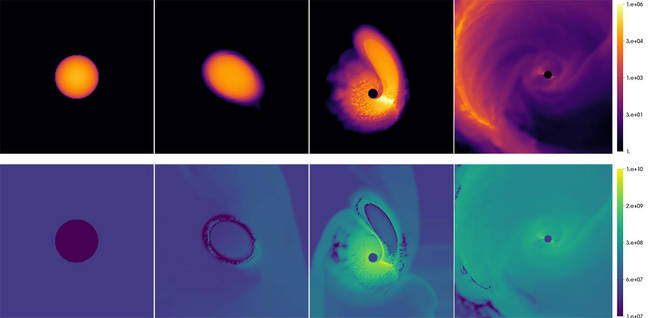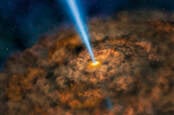This article is more than 1 year old
Black holes can briefly bring dead white dwarf stars back to life
Powerful tidal forces can restart fusion processes
Black holes can bring dead stars back to life - even if it’s just for a few seconds, according to a new study.
When stars teeter too close to the menacing voids, they can kickstart tidal disruption events (TDEs). Stars are yanked in towards the black hole by its strong gravitational field, and are eventually ripped apart by the extreme tidal forces.
A group of physicists studied and modelled the interaction using computational simulations based on equations from general relativity. They found that during the violent process luminous stars are destroyed, whereas dim white dwarfs leftover from the core of dead stars are resurrected. The strong tidal forces can compress the white dwarfs and trigger thermonuclear reactions for a few seconds.

Images taken from the computer simulations of a white dwarf being tidally disrupted by a local black hole of 1000 solar masses. Image credit: Anninos et al.
It’s a “likely outcome” if the white dwarf is massive enough and if the tidal compression is strong enough, according to the paper out on arXiv. The compression strength depends on the mass of the black hole, it should lie in the intermediate mass range of about 100 to 100,000 times the mass of the Sun.
If a black hole is too small, its gravitational effects are minimal. If it’s too large, however, then the white dwarf is more likely to be engulfed by the black hole before its tidal forces can take over. Either way, the compression forces aren’t sufficient enough to kickstart the thermonuclear fusion process and the white dwarf stays dead.
“It is important to know how many intermediate mass black holes exist, as this will help answer the question of where supermassive black holes come from,” said Chris Fragile, co-author of the study and a physics and astronomy professor at the College of Charleston, South Carolina. “Finding intermediate mass black holes through tidal disruption events would be a tremendous advancement.”
The paper has been accepted and is expected to appear in The Astrophysical Journal. ®

